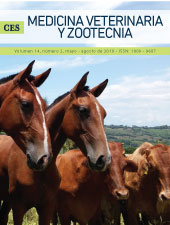Presence of mycotic microorganisms in raw milk from cooling tanks in the Boyacense highlands (Colombia)
DOI:
https://doi.org/10.21615/cesmvz.14.2.1Abstract
Yeasts and molds are germs that should not be found in milk samples because they are potentially pathogenic for both animals and humans. Due to its high handling during collection, storage, and transport, milk is susceptible to contamination with these microorganisms, so its detection in this food in these phases is relevant in order to prevent possible situations that compromise public health. The objective of the present work was to determine the presence of molds and yeasts in samples of milk cooling tanks in the Boyacense highlands. Samples were taken from 20 raw milk cooling tanks located in 20 different dairy municipalities of the department of Boyacá in order to determine the presence of molds and yeasts through Compact Dry YM®. 35% of the samples of milk did not present growth of molds or yeasts, meanwhile, in 25% yellow colony growth and its tonalities were found, which would correspond with mold colonies, in 5% determined the growth only of blue colonies, corresponding to yeast growth. In the remaining 35% growth of blue and yellow colonies was detailed. This shows that there is a high percentage of molds and yeasts in samples of refrigerated raw milk, a situation that could trigger a public health problem.
Downloads
References
2. Andrade RJ, Pulido MO, Rodríguez CE. Sanidad de ubre, calidad de leche. 1ra ed. Colombia. Universidad Pedagógica y Tecnológica de Colombia; 2012.
3. Beuchat LR, Mann DA, Gurtler JB. Comparison of dry sheet media and conventional agar media methods for enumerating yeast and molds in food. J Food Prot 2007; 70 (11): 2661–2664.
4. Camacho A, Giles M, Ortegón A, Palao M, Serrano B, Velásquez O. Técnicas para el Análisis Microbiológico de Alimentos. 2da ed. México. Universidad Nacional Autónoma de México; 2009.
5. Carrero MB, Lopéz A. Aislamiento e identificación preliminar de hongos contaminantes en queso Paipa del municipio de Paipa, Boyacá. Vitae 2012; 19 (1): 114-116.
6. Chipilev N, Daskalov H, Stoyanchev T. Study on the prevalence of lipolytic yeasts and molds in raw cow milk and white brined cheese. Bulg J Vet Med 2016; 19 (2): 117-126.
7. Delavenne E, Mounier J, Asmani K, Jany J, Barbier G, et al. Fungal diversity in cow, goat and ewe milk. Inter J Food Micro 2011; 151 (2). 247-251. 8. Gaghercole J, Reis GM, Agnew M, Reis MM, Humphrey R, et al. Molecular modification associated with the heat treatment of bovine milk. Inter Dairy J 2011. 73, 74-83.
9. Godič K, Golc S. The microbiological quality of raw milk after introducing the two day´s milk collecting system. A agri Slov 2008b; 92 (1): 61-74.
10. Godič K, Vengust A. The presence of yeast, molds and aflatoxin M1 in raw milk and chesse in Slovenia. J Food Cont 2008a; 19 (1): 570-577.
11. Instituto De Hidrología, Meteorología Y Estudios Ambientales De Colombia, IDEAM. Sistema de información ambiental 2018; [acceso: 05 de marzo de 2018] URL: http://www.ideam.gov.co.
12. Jodral M, Liñan E, Acosta I, Gallego C, Rojas F, et al. Mycoflora and toxigenic Aspergillus Flavus in spanish milks. Inter J Food Micro 1993; 18 (2): 171-174.
13. Kamkar A. A study on the occurrence of aflatoxin M1 in raw milk produced in Sarab city of Iran. J Food Cont 2005;16 (7): 593-599
14. Kiama TN, Lindahl JF, Sirma AJ, Waithanji EM, Ochungo PA, et al. Kenya dairy farmer perception of moulds and mycotoxins and implications for exposure to aflatoxins: A gendered analysis. Afr J Food Agri, Nut Dev 2016; 16 (3): 11106-11125.
15. Lavoie K, Touchette M, Stgelais D, Labrie S. Characterization of the fungal microflora in raw milk and specialty chesses of the province of Quebec. Dairy Sci Technol 2012; 92: 455–468
16. Liu W, Zheng Y, Kwok L, Sun Z, Zhang J, et al. High-throughput sequencing for the detection of the bacterial and fungal diversity in Mongolian naturally fermented cow´s milk in Russia. BCM Micro 2015; 15: 45-57.
17. Mbuk EU, Kwaga JK, Bale JO, Umoh JU. Molecular identification of yeast associated with raw cow milk from peri-urban farms in Kaduna State, Nigeria J Yeast Fun Res 2016; 70 (5): 39-46.
18. Mercado M, González V, Rodríguez D, Carrascal AK. Perfil sanitario nacional de leche cruda para consumo humano directo. 1ra ed. Colombia. Pontifica Universidad Javeriana- Ministerio de Salud y Protección Social; 2013.
19. Ministerio De Agricultura Y Desarrollo Rural, Unidad de seguimiento de precios de leche, USP 2018; [acceso: 18 de abril de 2018]. URL: http://ftpleche.minagricultura.gov.co/.
20. Mizouchi S, Nelson M. Matrix extension study: validation of Compact Dry Ym for enumeration of yeast and mold in selected foods. J AOAC Inter 2016; 99 (3): 695-704.
21. Neveen SM, Salwa AA. Occurrence and identification of yeast species isolated from Egyptian Karish cheese. J. Yeast Fun Res 2011; 2 (4): 59-64
22. Ortiz EP, Pérez RA, Orozco CA. Identificación de agentes micóticos en muestras de leche obtenidas en tanques de enfriamiento. Rev Cien Agri 2017; 14 (2): 99-106.
23. Panelli S, Brambati E, Bonacina C, Feligini M. Diversity of fungal flora in raw milk from the Italian Alps in relation to pasture altitude. Sp P Journal 2013; 2 (1): 405-414.
24. Pukančíková L, Lipničanová S, Kačániová M, Chmelová D, Ondrejovič M. Natural microflora of raw cow milk and their enzymatic spoilage potential. Nova Biotech et Chim 2016; 15 (2): 142-155.
25. Segundo C, Cervantes RA, Ducoing AE, De La Peña A, Villa L. Yeast isolation from bovine mammary glands under different mastitis status in the Mexican High Plateu. Rev Iber Mic 2011; 28 (2): 79-82.
26. Solera JS; Laboratorios Microkit. Certificado de validación de análisis de alimentos 2009; [acceso: 30 de mayo de 2018]. URL: https://www.microkit.es> publicaciones.
27. Spanamberg A, Wünder EA, Brayer DI, Argenta J, Cavallini EM, et al. Etiología de la mastitis bovina producida por levaduras en el sur de Brasil. Rev Iber Mic 2008; 25 (3): 154-156.
28. Williamson JH, Di Menna ME. Fungi isolated from bovine udders, and their possible sources. N Z Vet J 2007; 55 (4): 188-190.
29. Zeinab AM, Warda AG, Abdel G, Hamid D. Isolation and identification of lactic acid bacteria and yeast from raw milk in Khartoum State (Sudan). Res J Micro 2008; 3 (3): 163-168.
Downloads
Published
How to Cite
Issue
Section
License

This work is licensed under a Creative Commons Attribution-NonCommercial-ShareAlike 4.0 International License.
| Article metrics | |
|---|---|
| Abstract views | |
| Galley vies | |
| PDF Views | |
| HTML views | |
| Other views | |



